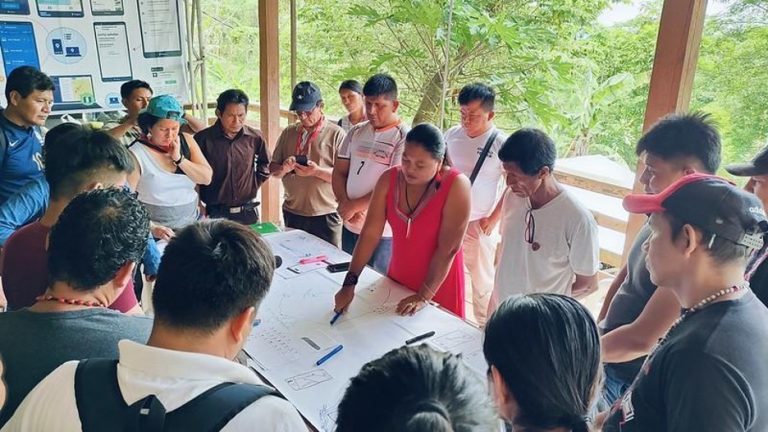Cisco Foundation Grantees Prioritize Indigenous Leadership To Protect the Amazon Basin
By Alex Wilkins
Published 02-16-24
Submitted by Cisco Systems, Inc.

This is the first of our three-part series on Cisco Foundation grantees working in the Amazon and South America region. This series will introduce you to eight Cisco Foundation Climate Impact & Regeneration grantees working to support preservation and protection of the Amazon basin through three main avenues, all of which are deeply entangled and in tandem serve to promote enduring environmental protection and preservation: Prioritizing Indigenous Sovereignty, Promoting Sustainable Livelihood Opportunities, and Scaling Innovative Financing Opportunities.
This article was constructed in partnership with my colleagues at Amazon Sacred Headwaters Alliance: Atossa Soltani, Uyunkar Domingo Peas, Rafalea Iturralde; and Digital Democracy: Jen Castro, and Megan Barickman.
The Amazon is a vast tropical rainforest, spanning nine South American countries, and is known for its rich biodiversity and cultural vibrancy. Indeed, the numbers are breathtaking: the Amazon covers 6.7 million square kilometers, is home to over 47 million people, (about 2 million of whom are Indigenous), stores an estimated 200 billion tons of carbon, and is home to approximately 10% of the world’s remaining biodiversity (World Wildlife Fund: Living Amazon Report, 2022). Beyond these regional numbers, though, the Amazon is important at a wider scope: large swaths of water vapor known as “atmospheric rivers” above the Amazon help to stabilize global temperatures and rainfall patterns around the world.
And yet, the ecosystem is facing enormous pressure from extractive industrial practices such as gold mining, oil drilling, and deforestation for timber and agricultural land. The scientific community now warns that if such unchecked degradation continues, the Amazon could reach a “tipping point,” triggering a massive and irreversible ecological die-off within decades. While such headlines may be concerning, radiating out from within the region is a spirit of energy, hope, and opportunity that sparks optimism and weaves together a collective vision of a resilient and inclusive future.
Cisco’s Chief Sustainability Office and the Cisco Foundation’s Climate Commitment seek to build capacity for our social and environmental systems to heal and thrive by working toward an inclusive, resilient, and regenerative climate future. Our work in the Amazon seeks to uphold these values, and enthusiastically supports several partners operating from within the region.
Indigenous Lands of the Amazon
The ecological significance of the Amazon bioregion is clear, but what often takes a backseat in modern discourse is its immense biocultural vitality. We cannot discuss Amazon preservation without centering and prioritizing Indigenous voices and acknowledging the necessity for Indigenous peoples to exercise self-determination within the lands they steward. Around the globe, some of the best-preserved and most resilient bioregions are those areas inhabited by Indigenous peoples. For example, land stewarded by Indigenous communities holds 80% of the world’s biodiversity. Within the Amazon, there are over 500 Indigenous groups who have inhabited over 300 million hectares of land since before European recorded history; and satellite imagery from the rainforest does show that land fully managed by Indigenous nations is the most well preserved. The Coordinator of the Indigenous Organizations of the Amazon Basin (COICA) is the preeminent leading organizational body acting on behalf of all 511 Indigenous groups in the Amazon (Please note: COICA’s primary language is Spanish).
Despite this data, very little funding for conservation and climate mitigation actually reaches Indigenous territories in regions across the globe. The Amazon is no exception. To effectively invest and support resilient ecosystems, it is crucial that we shift the main paradigm of ecosystem preservation and protection into the hands of the forest’s original stewards: Indigenous peoples. Two Cisco Foundation grantees are taking monumental strides to herald in that future by prioritizing Indigenous sovereignty through governance and digital access.
Amazon Sacred Headwaters Alliance: Indigenous Governance & Self-Determination
Cisco Foundation grantee Amazon Sacred Headwaters Alliance (ASHA) is an alliance founded in 2017 by Amazon Indigenous federations in Ecuador and Peru, including COICA with a goal to permanently protect and restore 86 million acres of rainforest within the Amazon headwaters, in the Napo, Pastaza, and Marañon basins. The alliance has now grown to include 24 Indigenous organizations and 3 non-governmental organizations (NGOs). According to Uyunkar Domingo Peas, the President of ASHA’s Board of Directors, these organizations are “joining together to mobilize significant financial and technical resources to ensure that our voices are heard, our rights are recognized, and our territories are protected.”
Domingo explains that comprehensive alliance is vital for the region, because “we all belong to the same interconnected web of rivers and forests. We are all kin, and when we unite, we can better protect our lands and our rights.” The guiding vision for ASHA, and many people within the region, is Buen Vivir, or the concept of collective well-being. To bring Buen Vivir to life, the Alliance co-created the Bioregional Plan 2030, which seeks to address five shared objectives: “improving living conditions, advancing Indigenous rights and territorial governance, stopping deforestation and degradation, conserving forests and restoring degraded areas, and stopping the advancement of extractive industries (ASHA).”
The Bioregional Plan emphasizes working closely with government leaders to promote a new economic paradigm, where extractive industries are foregone in favor of what Domingo describes as a “regenerative standing forest bioeconomy.” This future, according to Domingo, is not actually a sacrifice but instead a “Win-Win-Win: For Indigenous peoples, the Earth’s biosphere, and the nation’s long-term economic prosperity.” And how to practically bring Buen Vivir to life? Well, according to ASHA, it will take “significant levels of international funding, investments and financial mechanisms (e.g. debt forgiveness, climate and biodiversity adaptation and mitigation funds, philanthropy) can be mobilized and leveraged to incentivize the protection of the Sacred Headwaters region.”
Digital Democracy: Co-Building Indigenous Digital Futures
Another Cisco Foundation grantee, Digital Democracy, partners with remote front-line communities to help them address climate change and defend their rights through accessible technology. Crucial to Digital Democracy’s approach is “co-creation,” wherein product development is led largely by Indigenous partners and involves deep listening practices. In their own words: “Co-creating digital tools with Indigenous land defenders is critical because very little technology currently exists that meets their needs. Instead, technology is often used against Indigenous Peoples who are living in close relationship with nature and trying to protect vast, climate-sensitive ecosystems from destructive industries.”
According to Co-Director Jen Castro, at the organization’s inception in 2008, their partners needed technology that didn’t yet exist, such as “mapping tools that worked offline, allowed for offline collaboration amongst users, and supported data sovereignty, and tools that help them tell their own story in a digital world.” In practice, Indigenous earth defenders in the Amazon require tools to document threats such as oil spills or illegal logging. That data can then be used in legal cases or when seeking resources. Digital Democracy’s custom and flagship product Mapeo fills this gap: it is a free, open-source digital toolset that allows users to document, monitor, and map many types of data, completely offline. Digital Democracy’s work has contributed to 70 projects in nearly 40 countries with 7 million hectares of territory mapped and defended.
When asked about their current vision for the future, Digital Democracy painted a very clear picture: “The future we imagine is one of abundance and climate justice, in which Indigenous communities have sovereignty over their territories and their digital futures. We hope the tools we are co-building with our Indigenous partners will help lay the groundwork for this future.”
Uniting the Cisco Foundation, Amazon Sacred Headwaters Alliance, and Digital Democracy is a singular vision: one of a thriving, harmonious and resilient Amazon ecosystem, in which local Indigenous communities are active leaders, fully sovereign on their lands, leading the driving paradigm of preservation and protection.
The thread that weaves together three very different organizations is the pursuit of this vision — whether through Buen Vivir, Digital Sovereignty, or Resilient Ecosystems. If our goal is regeneration and a future where environmental systems are healthy and thrive, we get there by protecting human rights; facilitating diversity, inclusion, and equitable opportunity; and empowering local communities.
Stay tuned for the next article in our series about ecosystem restoration and regeneration through sustainable livelihood opportunities in the Amazon and South America.
View original content here.

Cisco Systems, Inc.
Cisco Systems, Inc.
About Cisco
Cisco (NASDAQ: CSCO) is the worldwide leader in technology that powers the internet. Cisco inspires new possibilities by reimagining your applications, securing your data, transforming your infrastructure, and empowering your teams for a global and inclusive future. Discover more on The Network and follow us on Twitter.
About Cisco's Purpose
Cisco’s purpose is to Power an Inclusive Future for All. From increasing access to skills needed to thrive in a digital economy to supporting the most vulnerable in times of crisis, we’re committed to using our technology for good. Cisco is also leveraging our scale and innovation to help ensure that our increasingly digital future is sustainable, inclusive, and resilient.
More from Cisco Systems, Inc.

